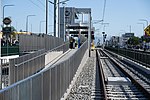Fairview Heights station (Los Angeles Metro)
California railway station stubsInglewood, CaliforniaK Line (Los Angeles Metro) stationsLos Angeles County, California geography stubsLos Angeles Metro stubs ... and 3 more
Railway stations in the United States opened in 2022Use mdy dates from November 2023Wikipedia page with obscure subdivision

Fairview Heights station is an at-grade light rail station on the K Line of the Los Angeles Metro Rail system. It is located alongside Redondo Boulevard and near the intersection of Florence Avenue and West Boulevard in Inglewood but near the Hyde Park neighborhood of Los Angeles. The station opened on October 7, 2022. Metro held a ceremonial ribbon cutting ceremony for the station on August 20, 2022.The station incorporates artwork by the artist Kim Schoenstadt.The Fairview Heights station will be the western trailhead of the Rail to Rail bike path.
Excerpt from the Wikipedia article Fairview Heights station (Los Angeles Metro) (License: CC BY-SA 3.0, Authors, Images).Fairview Heights station (Los Angeles Metro)
East Florence Avenue, Inglewood
Geographical coordinates (GPS) Address Nearby Places Show on map
Geographical coordinates (GPS)
| Latitude | Longitude |
|---|---|
| N 33.975347 ° | E -118.335989 ° |
Address
East Florence Avenue
90305 Inglewood
California, United States
Open on Google Maps






